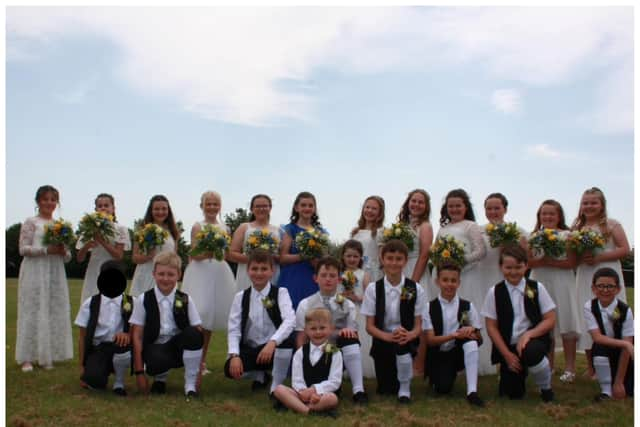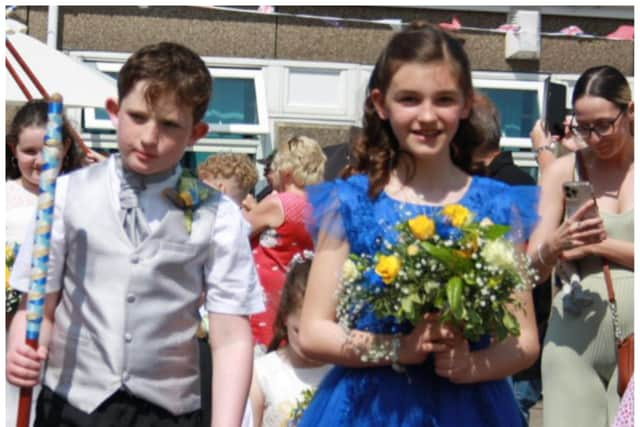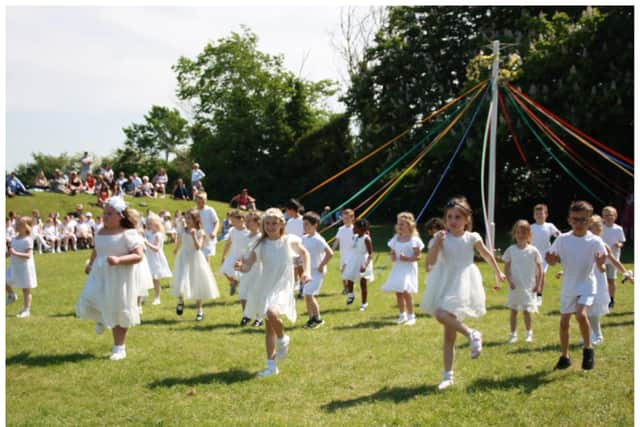Record crowds as Doncaster village celebrates 100 years of maypole celebrations
and live on Freeview channel 276
Wadworth has been the centre of the yearly seasonal celebrations which are thought to stretch back much further – but modern records for the event only date back to 1923.
Louise Wollerton of Wadworth Primary School, which organised and hosted the event, said: “It was attended by almost 500 people – we think this is a record.
Advertisement
Hide AdAdvertisement
Hide Ad"Several previous Maypole Queens were in attendance and the display showing the 100 years was very popular.


“The school raised money for new playground equipment and overall we raised a massive £1,600 - I think this too is a record.”
The May Queen was Autumn and the Herald was Leonidas, both from year 6.
The Page was Ivan and the Flower Girl was Maisie, both from the Reception class.
Advertisement
Hide AdAdvertisement
Hide AdShe added: “We were joined by a number of small businesses including Brewpark Coffee, Ladybird Kids Knits, Coopers Creative Crafts plus others.”


The tractor and trailer which the May Queen and her attendants travelled around the village in was supplied by Slack's butchers.
Meanwhile, the parade around the village was led by the headteacher Emma Cave who was then followed by all the children, staff and parents.
The local police, headed by Sergeant Martin Maw, helped with the traffic along the A60 and then brought cars and equipment into the school grounds for the children to investigate, while Civic Mayor Duncan Anderson was also in attendance.
Dances were choreographed by the teachers and other staff.


Advertisement
Hide AdAdvertisement
Hide AdAdded Louise: “All year groups took part in one traditional Maypole dance and another more modern with popular music. Year 5 are the year group who dance the traditional Ribbon Dances around the Maypole and were instructed by Alison Vernon.”
She added: “It was an exhausting day but well worth it and we hope that this will increase the profile of our small community village school.”
What is a maypole?
A maypole is a tall wooden pole erected as a part of various European folk festivals, around which a maypole dance often takes place.
The festivals may occur on 1 May or Pentecost (Whitsun), although in some countries it is instead erected at Midsummer (20–26 June).
Advertisement
Hide AdAdvertisement
Hide AdPrimarily found within the nations of Germanic Europe and the neighboring areas which they have influenced, its origins remain unknown.
It has often been speculated that the maypole originally had some importance in the Germanic paganism of Iron Age and early Medieval cultures and that the tradition survived Christianisation, albeit losing any original meaning that it had.
English historian Ronald Hutton concurs with Swedish scholar Carl Wilhelm von Sydow who stated that maypoles were erected "simply" as "signs that the happy season of warmth and comfort had returned."
Their shape allowed for garlands to be hung from them and were first seen, at least in the British Isles, between AD 1350 and 1400 within the context of medieval Christian European culture.
Advertisement
Hide AdAdvertisement
Hide AdThe practice became increasingly popular throughout the ensuing centuries, with the maypoles becoming "communal symbols" that brought the local community together – in some cases, poorer parishes would join up with neighboring ones in order to obtain and erect one, whilst in other cases, such as in Hertfordshire in 1602 and Warwickshire in 1639, people stole the poles of neighboring communities, leading to violence.
Under the reign of Edward VI in England and Wales, Protestant Anglicanism was declared to be the state religion, and under the Reformation many maypoles, such as the famous Cornhill maypole of London, were destroyed; however when Mary I ascended the throne after Edward's death, she reinstated Roman Catholicism as the state faith, and the practice of maypoles was reinstated.
Under later English monarchs, the practice was sporadic, being banned in certain areas, such as Doncaster, Canterbury, and Bristol, but continuing in many others, according to the wishes of the local governors.
What is a maypole dance?
The dance is performed by pairs of boys and girls (or men and women) who stand alternately around the base of the pole, each holding the end of a ribbon. They weave in and around each other, boys going one way and girls going the other and the ribbons are woven together around the pole until they meet at the base.
What is a May Queen?
Advertisement
Hide AdAdvertisement
Hide AdIn the British Isles and parts of the Commonwealth, the May Queen or Queen of May is a personification of the May Day holiday, and of springtime and also summer.
The May Queen is a girl who rides or walks at the front of a parade for May Day celebrations. She wears a white gown to symbolise purity and usually a tiara or crown. Her duty is to begin the May Day celebrations. She is generally crowned by flowers and makes a speech before the dancing begins.